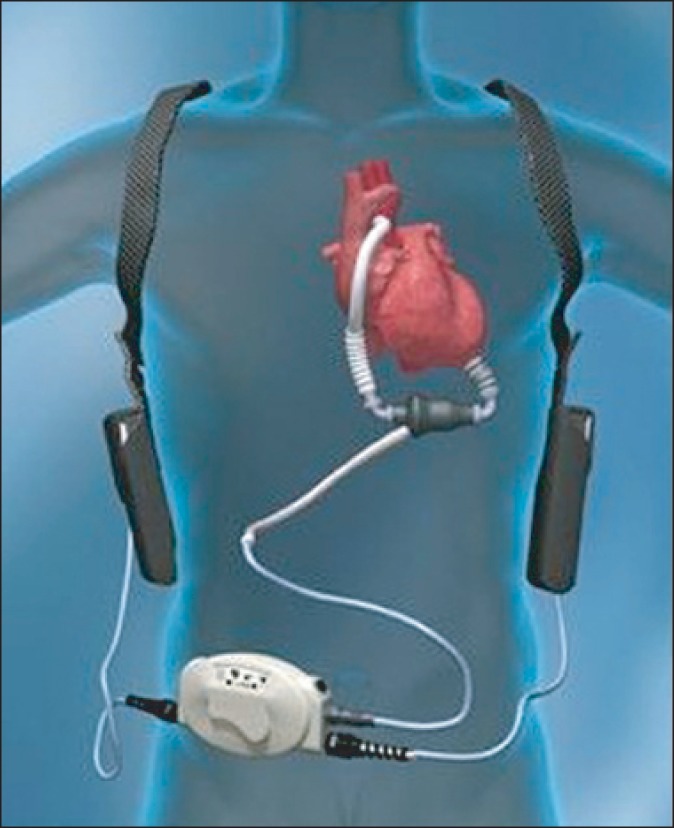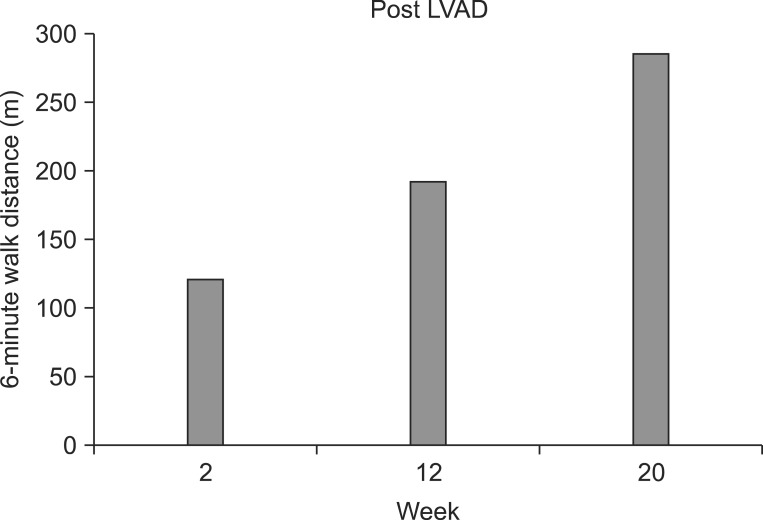Ann Rehabil Med.
2014 Jun;38(3):396-400. 10.5535/arm.2014.38.3.396.
Exercise Therapy for an Older Patient With Left Ventricular Assist Device
- Affiliations
-
- 1Divison of Sports Medicine, Department of Physical Medicine and Rehabilitation, Samsung Medical Center, Sungkyunkwan University School of Medicine, Seoul, Korea. yongon79@naver.com
- 2Department of Internal Medicine, Samsung Medical Center, Sungkyunkwan University School of Medicine, Seoul, Korea.
- KMID: 2165759
- DOI: http://doi.org/10.5535/arm.2014.38.3.396
Abstract
- A left ventricular assist device (LVAD) is a mechanical circulation support implanted for patients with end-stage heart failure. It may be used either as a bridge to cardiac transplantation or as a destination therapy. The health of a 75-year-old man with a medical history of systolic heart failure worsened. Therefore, he was recommended to have implanted a LVAD (Thoratec Corp.) as a destination therapy. After the surgery, he was enrolled in patient cardiac rehabilitation for the improvement of dyspnea and exercise capacity. In results, there is an improvement on his exercise capacity and quality of life. For the first time in Korea, we reported a benefit of exercise therapy after being implanted with a LVAD.
MeSH Terms
Figure
Reference
-
1. Go AS, Mozaffarian D, Roger VL, Benjamin EJ, Berry JD, Borden WB, et al. Heart disease and stroke statistics: 2013 update: a report from the American Heart Association. Circulation. 2013; 127:e6–e245. PMID: 23239837.2. Nissinoff J, Tian F, Therattil M, Salvarrey RM, Lee SW. Acute inpatient rehabilitation after left ventricular assist device implantation for congestive heart failure. PM R. 2011; 3:586–589. PMID: 21665171.
Article3. Miller LW, Pagani FD, Russell SD, John R, Boyle AJ, Aaronson KD, et al. Use of a continuous-flow device in patients awaiting heart transplantation. N Engl J Med. 2007; 357:885–896. PMID: 17761592.
Article4. Corra U, Pistono M, Mezzani A, Gnemmi M, Tarro Genta F, Caruso R, et al. Cardiovascular prevention and rehabilitation for patients with ventricular assist device from exercise therapy to long-term therapy. Part I: Exercise therapy. Monaldi Arch Chest Dis. 2011; 76:27–32. PMID: 21751735.
Article5. Reedy JE, Swartz MT, Lohmann DP, Moroney DA, Vaca KJ, McBride LR, et al. The importance of patient mobility with ventricular assist device support. ASAIO J. 1992; 38:M151–M153. PMID: 1457836.
Article6. Hasin T, Topilsky Y, Kremers WK, Boilson BA, Schirger JA, Edwards BS, et al. Usefulness of the six-minute walk test after continuous axial flow left ventricular device implantation to predict survival. Am J Cardiol. 2012; 110:1322–1328. PMID: 22819427.
Article7. Grady KL, Meyer PM, Mattea A, Dressler D, Ormaza S, White-Williams C, et al. Change in quality of life from before to after discharge following left ventricular assist device implantation. J Heart Lung Transplant. 2003; 22:322–333. PMID: 12633700.
Article
- Full Text Links
- Actions
-
Cited
- CITED
-
- Close
- Share
- Similar articles
-
- Temporary Right Ventricular Assist Device Insertion via Left Thoracotomy after Left Ventricular Assist Device Implantation
- The First Pediatric Heart Transplantation Bridged by a Durable Left Ventricular Assist Device in Korea
- Central-Approach Surgical Repair of Coarctation of the Aorta with a Back-up Left Ventricular Assist Device for an Infant Presenting with Severe Left Ventricular Dysfunction
- The Effect of Individualized Exercise Parameters Applied to Two Patients Recovering from Implanted Left Ventricular Assist Devices in Korea
- Non-Surgical Resolution of Inflow Cannula Obstruction of a Left Ventricular Assist Device: A Case Report



